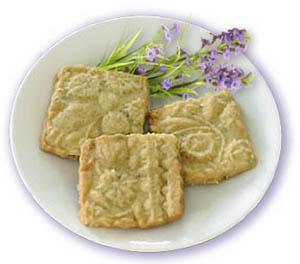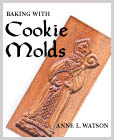
Using Lavender in Cookies
by Anne L. Watson
Maybe because I live in the Pacific Northwest, where lavender is almost a weed, I get asked about its use in baking from time to time. There’s a local lavender farm and store, and they sell lavender shortbread. This is an idea that, at first, did not appeal to me at all.
I bought some of their culinary lavender, thinking to include one recipe in my book, Baking with Cookie Molds, as a curiosity, if nothing else. It didn’t happen, and the little can of lavender buds stayed unopened in my spice rack.
 Finally, after more questions and requests, I tried it. First, though, I looked up complementary flavors to get an idea how to put a recipe together. I found that citrus, vanilla, and honey were recommended for use with lavender. Finally, after more questions and requests, I tried it. First, though, I looked up complementary flavors to get an idea how to put a recipe together. I found that citrus, vanilla, and honey were recommended for use with lavender.
So I worked out a variation of my basic shortbread recipe to incorporate those tastes.
The buds proved to be whole when I opened the can, and I decided they’d be much better ground. I used the food processor, and mixed the lavender buds with the sugar so there would be enough volume for the processor to work. When I thought it was ground as finely as possible, I sifted it through a large strainer.
Lavender Shortbread Cookies
1 cup (225 grams) softened butter
½ cup (100 grams) sugar, processed with 1 tablespoon culinary lavender buds
1 tablespoon honey
½ teaspoon vanilla
½ teaspoon natural lemon flavoring
¼ teaspoon natural orange flavoring
Finely grated peel of one small lemon
About 2 ¼ cups (315 grams) all-purpose flour (plain flour)
1. Cream the butter with the sugar.
2. Mix the honey, vanilla, lemon flavoring, and lemon peel. Add to the butter mixture.
4. Add flour slowly until the mixture is solid enough to knead. Transfer to your work surface and knead in enough additional flour to make a soft dough that will hold a shape. Mold per the directions for your cookie mold.
5. Bake in a 300 degree F (150 degree C) oven until lightly browned.
Notes on molds:
Small molds are best for shortbread, and an impression mold is easier to use on a delicate dough like this than a cavity mold. In other words, springerle molds or rollers are more likely to succeed here than gingerbread molds or Brown Bag molds.
I used a springerle rolling pin with an allover design and cut the dough into squares with fluted cookie cutters. I chilled it briefly so I could separate the cookies for baking, then baked one sheet at a time, keeping close watch so they didn’t overcook.
Since lavender buds, even when sifted, will make dark speckles in the dough, choose your cookie mold so that this won’t be a flaw in the pattern.
The flavor is good. It’s a complex flavor, unusual but not—as I had feared—soapy or perfumey.
 Anne Watson is the author of the newly released "Baking with Cookie Molds." The book can be found on Amazon and other book sites or look for her on her online Baking with Cookie Molds Magazine. Anne Watson is the author of the newly released "Baking with Cookie Molds." The book can be found on Amazon and other book sites or look for her on her online Baking with Cookie Molds Magazine.
Dried lavender can be purchased in many health food stores and some "gourmet" shops. It is also available from many places online. Do not purchase lavender to be used in cooking from a craft shop unless it says that it is suitable for food use. Lavender grown for non-food use may contain high levels of toxic pesticides.
To store, keep in an airtight container and store in a cool, dry location. |



